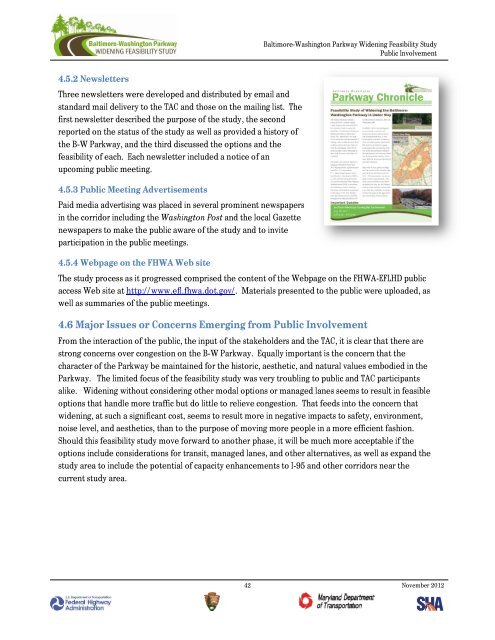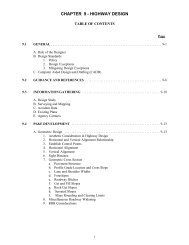Baltimore-Washington Parkway Widening Feasibility Study
Baltimore-Washington Parkway Widening Feasibility Study
Baltimore-Washington Parkway Widening Feasibility Study
- No tags were found...
You also want an ePaper? Increase the reach of your titles
YUMPU automatically turns print PDFs into web optimized ePapers that Google loves.
<strong>Baltimore</strong>-<strong>Washington</strong> <strong>Parkway</strong> <strong>Widening</strong> <strong>Feasibility</strong> <strong>Study</strong>Public Involvement4.5.2NewslettersThree newsletters were developed and distributed by email andstandard mail delivery to the TAC and those on the mailing list. Thefirst newsletter described the purpose of the study, the secondreported on the status of the study as well as provided a history ofthe B-W <strong>Parkway</strong>, and the third discussed the options and thefeasibility of each. Each newsletter included a notice of anupcoming public meeting.4.5.3PublicMeetingAdvertisementsPaid media advertising was placed in several prominent newspapersin the corridor including the <strong>Washington</strong> Post and the local Gazettenewspapers to make the public aware of the study and to inviteparticipation in the public meetings.4.5.4WebpageontheFHWAWebsiteThe study process as it progressed comprised the content of the Webpage on the FHWA-EFLHD publicaccess Web site at http://www.efl.fhwa.dot.gov/. Materials presented to the public were uploaded, aswell as summaries of the public meetings.4.6MajorIssuesorConcernsEmergingfromPublicInvolvementFrom the interaction of the public, the input of the stakeholders and the TAC, it is clear that there arestrong concerns over congestion on the B-W <strong>Parkway</strong>. Equally important is the concern that thecharacter of the <strong>Parkway</strong> be maintained for the historic, aesthetic, and natural values embodied in the<strong>Parkway</strong>. The limited focus of the feasibility study was very troubling to public and TAC participantsalike. <strong>Widening</strong> without considering other modal options or managed lanes seems to result in feasibleoptions that handle more traffic but do little to relieve congestion. That feeds into the concern thatwidening, at such a significant cost, seems to result more in negative impacts to safety, environment,noise level, and aesthetics, than to the purpose of moving more people in a more efficient fashion.Should this feasibility study move forward to another phase, it will be much more acceptable if theoptions include considerations for transit, managed lanes, and other alternatives, as well as expand thestudy area to include the potential of capacity enhancements to I-95 and other corridors near thecurrent study area.42 November 2012
















